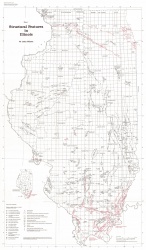Girard Faults
Location
Christian, Sangamon, Macoupin, and Montgomery Counties (G-4)
References
Krausse et al. 1979b, Nelson and Nance 1980, Nelson 1981, 1987b, Ledvina 1988
Description
Ledvina (1988) gave the name Girard Faults to a group of northwest-trending faults encountered in underground coal mines in west-central Illinois. The Girard Faults do not fit the definition of a fault zone or system; but because of similar trend and geometry, they appear to be related (Nelson and Nance 1980, Nelson 1981, 1987b). The type example is located in the workings of the Crown II coal mine near Girard, Macoupin County (fig. 38, G-4 on plate 1). The Sicily Fault in Christian County (F-5 on plate 1) may also be considered one of the Girard Faults. Other Girard Faults are too small to show at the scale of plate 1.
These faults are linear in map view and strike northwest to north-northwest. They dip at moderate angles of 35° to 70° and exhibit little or no drag. The largest Girard Faults are several miles (km) long and have displacements up to 18 feet (5.5 m); most are much smaller. There is little or no gouge, breccia, or mineralization. Slickensides indicate dip-slip displacements. Units displaced include the Herrin Coal Member and adjacent roof and floor strata.
The Girard Faults differ from the "clay-dike faults" that are numerous in many coal mines (Krausse et al. 1979b). clay-dike faults are strongly curved in strike and dip, exhibit "false drag" and clay fillings, and generally do not cut all the way through the coal. They are evidently non tectonic faults that formed before the sediments were lithified. The linearity and parallelism of Girard Faults implies origin in a tectonic stress field , but the low dip angle suggests that they developed early during lithification. They may have dipped steeply initially, but subsequently, compaction reduced the dip angle.
One of the Girard Faults intersects the left-lateral Crown Fault within the mine workings. The Crown Fault offsets and therefore is younger than the Girard fault (fig. 29). Furthermore, the faults must have formed in different stress fields. The principal stress responsible for the Crown Fault was oriented northeast to southwest, whereas the Girard fault developed under a principal stress directed northwest to southeast.
See also CROWN FAULT and SICILY FAULT.


